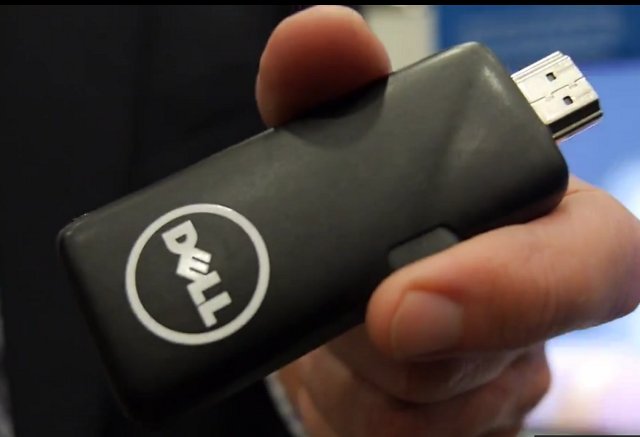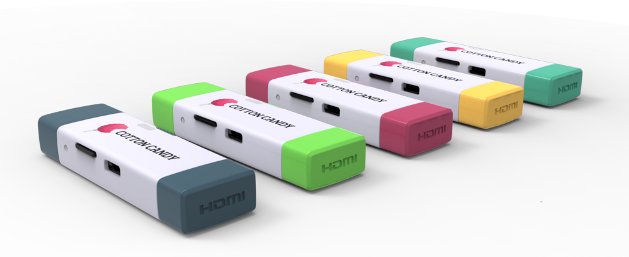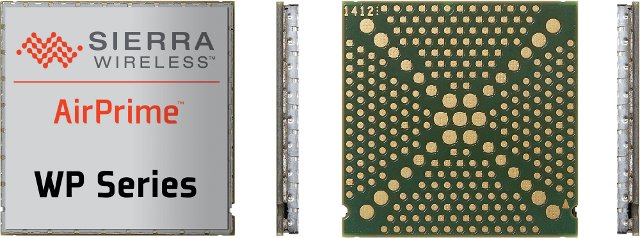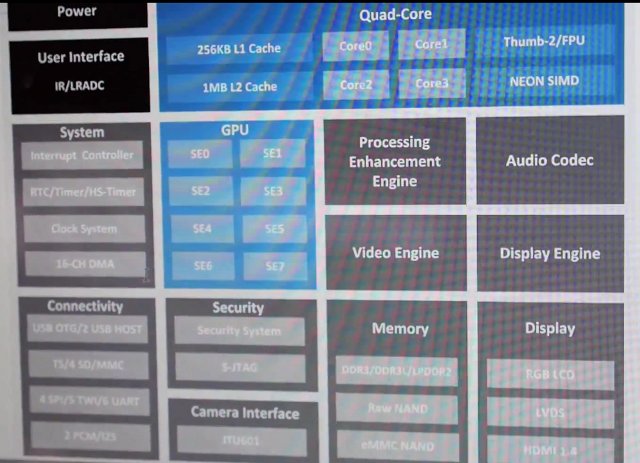As announced at CES 2013, Dell will be the first multinational company to enter the Android mini PC with Project Ophelia, a mini PC powered by Rockchip RK3066 with 1 GB RAM and 8 GB Flash, which would just be an American copy of Chinese products without support for MHL, and PocketCloud, a software suite to access your computers’ desktop remotely, create your own private cloud, and manage your devices remotely. The specifications have not been disclosed, but I could gather some specs mainly from CNET: SoC- Rockchip RK3066 Dual Core Cortex A9 @ 1.6Ghz System Memory – 1GB RAM Storage – 8GB Flash + micro SD Connectivity: Bluetooth Wi-Fi 802.11 b/g/n (with push to connect button) Video Output – HDMI / MHL USB – microUSB Dimensions – 8.89cm x 3.81cm You can either power the device via MHL if you have a compatible television, or via USB like most […]
FXI Technologies Cotton Candy HDMI Stick To Fully Support Both Android and Ubuntu
FXI Technologies was the first company to ever show an HDMI TV dongle when they unveiled the Cotton Candy in November 2011. Since then, many Chinese companies started to provide similar products at lower cost, and the company further improved the Cotton Candy, which is still powered by Exynos 4210 (dual core Cortex A9), by making it even smaller, and getting rid of the internal flash in the process. As a memory refresher, here are the specifications of the Cotton Candy: SoC – Samsung Exynos 4210 dual core Cortex A9 + Mali-400MP4 System Memory – 1GB DRAM Storage – No flash, up to 64GB microSD Video Output – HDMI Connectibity Wifi 802.11b/g/n Bluetooth 2.1 + EDR USB – USB 2.0 male connector for power and connection to devices that supports USB mass storage + microUSB Video Codecs- 480p/720p/1080p Decode of MPEG4-SP/H.263/H.264 AVC/MPEG-2/VC1 Audio Codecs – MP3, AAC, AAC+, Real Audio […]
Ubuntu 11.10 on GK802/Hi802 mini PC with 2D/3D and Video Hardware Acceleration
You may remember an Ubuntu 11.10 image was released via Geekbuying early January, but this image would not boot on my Hi802, lacked 2D/3D acceleration, and to my knowledge there hasn’t been any update since then. So hope of proper Linux support on the device was fading, until the community discovered Freescale released patches for i.mx6 HDMI dongles, developers setup the imx6-dongle community, and after a lot of work, mainly by three members: Jasbir, Dmitriy (rz2k) and James, there’s now GPU and VPU support on Ubuntu 11.10. Here’s a summary of the current status: Wifi working. External SD working Matched IOMUX configuration to align with the Android image. Stripped out unnecessary device initialisation from the original HDMI dongle source. Enabled EGL and GLES HW Acceleration in Ubuntu. Unity desktop might be partially HW accelerated (TBC) Jasbir uploaded a video to YouTube to show the progress, and it looks pretty good. […]
How to Run Android Apps in Linux with AndroVM
You may want to run some Android applications in your computer. If you’re using Windows, there’s already a decent option with Bluestacks. If you’re using Linux, you could always install the Android SDK and run the emulator, but I don’t really like this option because of the user interface, and for people who don’t need to use the SDK it’s not really the simplest thing to install. The way to run Android apps in Linux is probably to run an x86 Android virtual machine in VirtualBox. Yesterday, I tried the latest development version of Android x86 4.2, but for some reasons I could not control the mouse, and had to perform all tasks with the keyboard. What I’m going to use today instead is AndroVM, an Android VM for x86 processor, that is even more easy to use than the Android x86 image. The instructions has been performed in a […]
Zopfli Library Improves Zlib Compression by 3 to 8%
Google developers have released a new compression library called Zopfli. This library, written in C, is compatible with zlib, yet provide a better compression, more exactly 3 to 8% according to Google. This library can be used on servers for better compression in order to save bandwidth, as well as delivering web pages faster. Since it’s fully compatible with zlib, the web browsers do not need to be changed. The only drawback is that it’s several magnitude slower than zlib, so it’s better used for static content that is compressed once, and sent over the Internet many times, and it may not be a good choice for dynamic content. The source code is available at https://code.google.com/p/zopfli/, so let’s try it. Get the code and build zopfli:
|
1 2 3 |
git clone https://code.google.com/p/zopfli/ cd zopfli make |
Different levels of compression are available:
|
1 2 3 4 5 6 7 8 9 10 11 12 13 14 15 16 17 |
./zopfli -h Usage: zopfli [OPTION]... FILE -h gives this help -c write the result on standard output, instead of disk filename + '.gz' -v verbose mode --gzip output to gzip format (default) --deflate output to deflate format instead of gzip --zlib output to zlib format instead of gzip --i5 less compression, but faster --i10 less compression, but faster --i15 default compression, 15 iterations --i25 more compression, but slower --i50 more compression, but slower --i100 more compression, but slower --i250 more compression, but slower --i500 more compression, but slower --i1000 more compression, but slower |
For testing purpose, I’ve just saved this blog as one html file (test.html – 67275 bytes) […]
Linaro 13.02 Release with Linux Kernel 3.8 and Android 4.2.2
Linaro 13.02 is now available, and features Linux Kernel 3.8 and Android 4.2.2. The biggest news this month is probably the first release of a preliminary ARM64 Debian/Ubuntu Raring image. Other noticeable items include work on ARMv7 KVM, more improvements to OpenEmbedded ARMv8 implementation, as well as big.LITTLE MP implementation, and some modifications to the toolchain for Cortex A7 support. Origen images are not available for download this month, and there’s still no ALIP images since they have disappeared since Linaro upgraded to Ubuntu Quantal. Here are the highlights of this release: Android AOSP master build for Galaxy Nexus has been setup All the platforms have been updated to 4.2.2 Support for lava-test-shell has been added to linaro-android-build-tools. Developer Platform CI bring up: ARMv7 KVM – Add Arndale hypervisor patch to u-boot-linaro. CI bring up: Arndale – Add Arndale image reports to LAVA, Enable and verify UEFI support in the […]
Sierra Wireless Airprime WP & AR Series Modules Feature Tricore M2M SoC
Sierra Wireless, a company providing machine-to-machine (M2M) solutions, has recently introduced a new (nameless) architecture for embedded wireless communications comprised of a multicore (again, nameless) “high speed application processor” + Cortex M0 MCU + Radio SoC, secure cloud services (AirVantage) to store the data, and an open application framework with M2M libraries and development tools. This new architecture will be available in the company’s AirPrime WP & AR Series wireless modules to provide 2G to 4G technologies for the Internet of things. WP Series are industrial grade modules to be embedded into applications such as smart metering, remote monitoring, transportation, security systems, networking, and healthcare, whereas AR series will be used for automotive applications. The 2G versions will feature an M2M system-on-a-chip with a advanced tri-core architecture that includes a 2G EDGE modem, a Cortex A5 ARM application processor, and an ARM Cortex-M0 processor to enable ultra-low power operation. The […]
AllWinner Announces A31s Processor for Phablets, Hints about Ubuntu Devices
AllWinner is currently a Mobile World Congress 2013, and Charbax had the chance to interview Eva, manager at AllWinner, and learn more about new processors, and future plans by the company. They spent some time discussing about AllWinner A31 and AllWinner A20 quad and dual Cortex A7 processors, but since we’ve know about those for a while I’ll skip this part. The most interesting part is about AllWinner A31s, a cost down version of A31, specifically designed for phablets (smartphones with 5″ to 7″ screens). Like AllWinner A31, AllWinner A31s is also a quad core Cortex A7 processor with PowerVR SGX544MP2 GPU (8 shader engines) and the following specifications: CPU – ARM Cortex-A7 Quad-Core with 256KB L1-Cache/1MB L2-Cache GPU – POWERVR SGX 544MP2 with 8 logic cores. OpenGL ES2.0, Open CL1.x and DX 9_3 compliant. Memory 32-bit Dual-Channel LPDDR2/DDR3/DDR3L Controller, 8-bit NAND FLASH Controller with 64-bit ECC Video UHD H.264 […]










